Related sites:
Newsletter: Perspectives on Power Platform
Company: Niiranen Advisory Oy
The user interface of Dynamics CRM has been cleaned up quite a bit in the latest 2013 version. The number of buttons visible to the user has been greatly reduced in the browser client. Another significant change from a usability perspective is that Dynamics CRM now operates like any other web application or website: within a single browser window, allowing you to navigate back & forth with the browser’s native buttons. The combination of these two factors has however lead to one side affect that may cause the users familiar with previous Dynamics CRM versions to ask the question: “Dude, where’s my Advanced Find?”
In CRM 2011 the Advanced Find was always available in the main window of CRM. Unless you resized the window to a small enough size and made the Data tab of the CRM 2011 Ribbon collapse into a single flyout button, it was pretty easy to spot the familiar binoculars icon that represented Advanced Find. Being one of the most powerful features of the Dynamics CRM application, this button will have surely become familiar to all power users of CRM over the years.
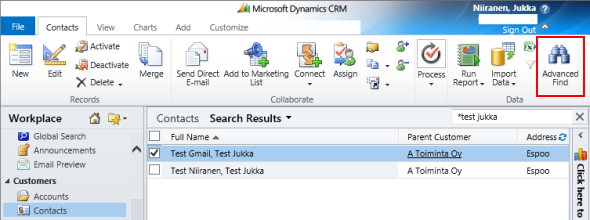
In CRM 2013 the Advanced Find feature is not always so easy to locate. I have observed quite many experienced users to struggle with locating the menu after the system has been upgraded. Also, when I was recently studying the Google search terms that had lead people to visit my blog, “CRM 2013 Advanced Find” and its variations appeared three times in the Top 20 searches. Since the Advanced Find feature itself has not really changed at all in the 2013 version compared to previous releases, I presume many of the questions people have in their mind while reaching out to a search engine may be related simply to “how to find Advanced Find” (as “meta” as that may sound).
If that’s the question you have, then let me first explain a bit about the logic behind the standard behavior of the new Dynamics CRM 2013 UI in different areas of the application. Then I’ll show you an alternative method that will make it much easier to launch Advanced Find from any place inside CRM.
When you open up the Dynamics CRM 2013 browser client with the default settings of a fresh new CRM organization, you’ll be taken onto the dashboard page. Here the button for opening Advanced Find is displayed prominently as one of the actions on the Command Bar, just like it would have in CRM 2011.
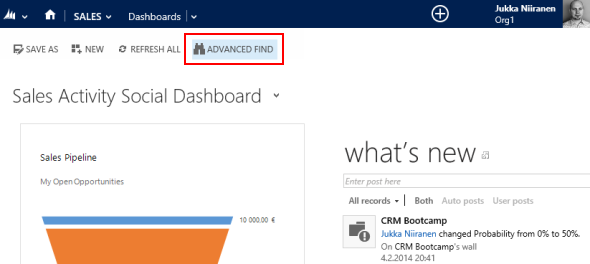
If we move forward to a list view of any entity, the Advanced Find button no longer appears directly on the page. Instead the user needs to click the ellipsis (three dots) to reveal the “more actions” menu, where one of the actions launches Advanced Find into a new popup window. Another alternative would be to expand the view selector menu and choose the last option of “Create Personal View”, which will also lead the user to the Advanced Find window.
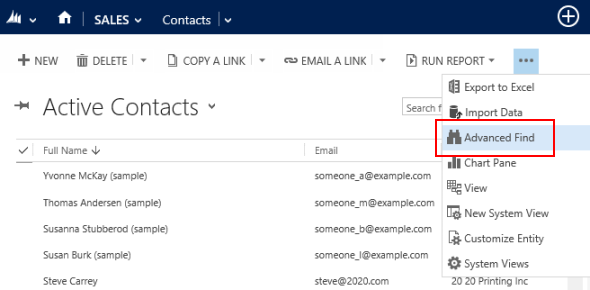
How about if we’ve navigated onto a record of an entity, such as a contact, and then realize we want to perform a search on other similar records? If we now repeat the same action of expanding the Command Bar menu via the ellipsis, there is no longer an option launch Advanced Find from here. Instead we’d need to go back in our steps to the Contact list view by clicking the label in the Navigation Bar. This would then land us on a window where the option is again available.
In a way this behavior makes sense, since the Command Bar actions visible on the record detail page are all related to the single record in question. Advanced Find also isn’t considered a “global” action in CRM that would be always present in the Navigation Bar (like the gear icon for opening the personal options menu), but rather it only makes its appearance when looking at a view of records (with the dashboard page being an exception to this rule). As Advanced Find really is a tool for building views, it is shown within this context of existing views for any record type.
If you need to frequently work with views in Dynamics CRM, to perform searches on records, study different data columns than the system views offer or perform data analysis of any kind, you might find yourself reaching out for Advanced Find quite often. Instead of having to first perform a check on what is the current page’s context and then determining the steps needed for launching Advanced Find, wouldn’t it be more convenient to just have a persistent button available that would always take you to that window?
Although Dynamics CRM itself doesn’t offer a direct way to bookmark the Advanced Find page, you can still easily grab its URL. In Internet Explorer, once you’ve opened up Advanced Find, press Ctrl+N to open it in a new window that contains the full browser controls. Now you can add it as a bookmark and place it on the Favorites bar (right-click on the top of the IE window to enable the bar if it’s not visible). The URL will be in the form of http://[servername]/[organizationname]/main.aspx?pagetype=advancedfind in an on-premises Dynamics CRM environment.

Wait, don’t leave just yet! There’s more to it! The URL will be a static link that points to your current CRM organization. If you ever need to work with more than one CRM environment (such as development, test, production instances), then that bookmark will not be of any help in the other organizations. Wouldn’t it be cool to have a context sensitive button that would always take you to the Advanced Find window of the CRM environment you’re currently accessing?
This is something we can achieve by using a less known trick called Javascript bookmarks. Essentially this means that instead of saving a URL in the bookmark, you’ll save a piece of script that will run when you click on the bookmark button. Blake Scarlavai from Sonoma Partners has been posting many great examples of how these Javascript bookmarks can be leveraged with Dynamics CRM and one of his recent articles contains the script for opening CRM 2013’s Advanced Find.
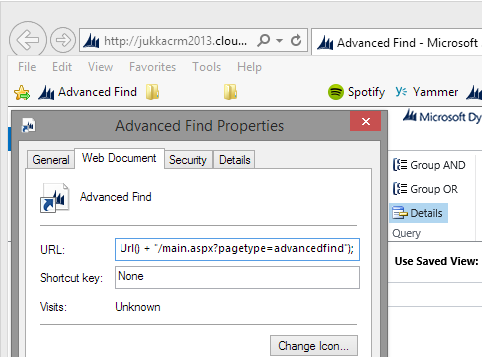
First copy the script from Blake’s article. Then right-click on the Advanced Find bookmark you created earlier and select Properties. In the properties dialog replace the URL field’s value with the script, then click OK. Now you have a true Global Advanced Find button available right within the browser window at all times, which will take you to the Advanced Find window of the CRM organization that you are currently viewing. Thanks for this great usability tip, Blake!
Now that we’re discussing the topic of Advanced Find usability, I decided to also briefly visit another area in which I very often see the users struggle: sharing their saved views with other users. While CRM does show the Share icon in both the list view and record detail Command Bars, this is not the place where you can share a view. You see, these sharing options are related to the share of the records you are working with. In the CRM data model a view is also one record type, but in order to perform the sharing action on them, we’ll actually need to find a view of views. Yes, a bit like “finding find”, also “viewing views” is a real concept that requires some thought when working with Dynamics CRM.
As mentioned, the Advanced Find UI itself has not changed from CRM 2011, so anyone who’s new to the application will discover the old Ribbon based user experience while working with views in CRM 2013. What makes the Advanced Find ribbon particularly challenging to grasp is that it doesn’t follow the exact same logic as with normal record forms and subgrids in CRM 2011. Instead, it presents three separate areas in the Show tab, out of which Query will be the area where you land after launching Advanced Find. The exclamation mark will run the query and take you to the Results list showing the records that match the criteria. In between these two buttons is the Saved Views area, which is where you need to click in order to access the “view of views”.

You’ll be presented with a list of the saved views for the entity that you had chosen on the previous Query area. If this is not the one you want, clicking the Record Type button will allow you to switch to another entity. Once you locate the correct view or views, highlight them and click on the Share button visible on the ribbon to launch the Share Saved View dialog.
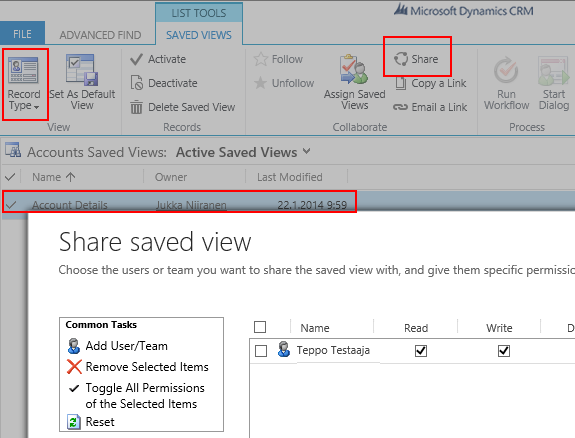
So, remember that views are shared just like any other record, but because they don’t have an actual record form, the only place to do this is from a list view. The Advanced Find window in turn is the only place where you’ll see this list, but under a secondary area that you don’t normally encounter while building new view criteria and verifying their results.
[…] to work with… Hey, wait a minute! That’s precisely what I did just a while ago with the global Advanced Find button! All I need to do now is to apply the awesome script from Sonoma Partners’ Blake Scarlavai […]
[…] http://jukkaniiranen.com/sandbox/2014/02/finding-advanced-find-crm-2013/ […]
Hi,
I read your article because we are updating CRM 2011 to CRM 2013, and i would like to ask you a question.
We are looking to have a Export permission in the shared views, is that possible?
Pablo, I’m not sure I understand the requirement. Do you wish to restrict the ability to export records from a view to Excel? You can turn the export permission on or off globally from the security roles. You can’t define this on a view level, since any user could simply re-create the view themselves and export the records after that.
Let me explain, for security reasons we have the export permission turned off globally.
So the solution to that allow some users to allow export is to create a role and assign them this role, but this compromises the security of all entities.
Its an all or nothing. So, if we can control the export permission based on a view we can restrict the access to full information in all entities.
The practical reason for doing this, its because some managers has this permission set to export but they need to share to theirs teams information based on views.
Pablo, may this kind of a solution could be the answer: http://www.toplinestrategies.com/dotneters/net/disabling-export-to-excel-in-ms-crm-2011-3/.
Is there a way to import existing advanved find queries into another instance of Microsoft Dynamics?
Tahnks
Joanne
Joanne, I haven’t performed such a migration myself, but the UserQuery entity does have APIs available for performing the reading and creation of saved views via custom code.
There’s also a Solution Extender tool available on CodePlex that is supposed to allow moving saved views between CRM instances.
I’ve been looking for some good CRM on premise, and I think that being able to do some reading would be helpful. I’m glad you talked about how you can create a shortcut button to help with CRM searches on records. I’m going to have to see if we can take advantage of a shortcut button or two, and get the CRM on premise help we need!